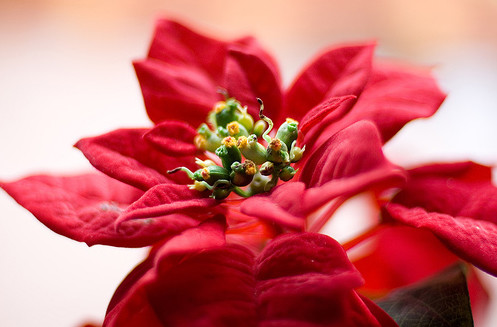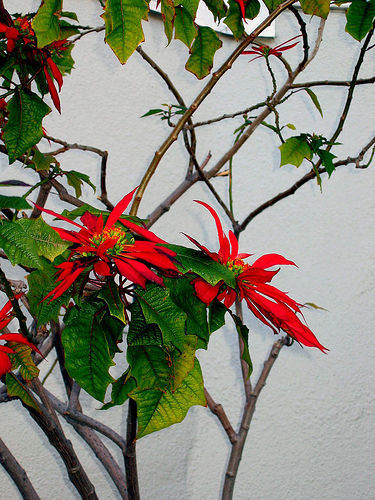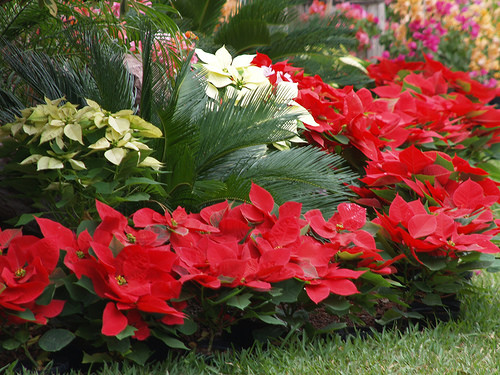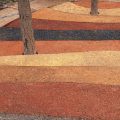 Exotic flowers It happened in Los Angeles inthe eve of the Christmas holidays of 1906. Gardener Paul Ecke came up with the idea of selling cut branches of poinsettia he raised. It is clear that to buy beautiful exotic flowers could be a special audience, so Ecke and put them on sale not anywhere, but in the windows of the Boulevard Sunset, in Hollywood. The original plants aroused great interest among wealthy residents of the city. It was from there that the new name of the bush, the "Christmas star", spread across the world. In fact, this unusual plant was especially lucky with names and legends. In Central America - in his homeland, where the shrub grows to three meters in height, the Aborigines called him the Cuetlaxochitle and he was the favorite plant of the leader of Montezuma. The locals treated him with a milky juice of fever, made from leaves dyes for face and tissues and added about his origin of the legend. According to the legend of the Aztecs, unhappy love broke the heart of their goddess. And from a drop of blood falling to the ground, a bush grew up, which in mid-December, suddenly, like stars, the purple leaves on the top bloom. It is the leaves, not the flowers, because the flowers of the poinsettia are rather small and inconspicuous, and the so-called bracts are flickering-modified bracts. With the advent of Europeans, the plant has become a symbol of another faith. Already in the XVII century, Franciscan monks who settled in the territory of modern Mexico, began to decorate the purple leaves poinsettii temples for Christmas, and soon this tradition spread throughout the country. Pagan Spanish colonists have laid down their Christmas story about the origin of poinsettia. One poor girl and her cousin had nothing to bring to the temple to decorate the altar. Then the children decided to pick at least a branch of the roadside bush. It was a modest, unattractive bouquet, but when the girl lovingly laid it at the feet of the infant of Christ, it suddenly blossomed. Since then, the plant began to be called "Flowers of the Holy Night".
Exotic flowers It happened in Los Angeles inthe eve of the Christmas holidays of 1906. Gardener Paul Ecke came up with the idea of selling cut branches of poinsettia he raised. It is clear that to buy beautiful exotic flowers could be a special audience, so Ecke and put them on sale not anywhere, but in the windows of the Boulevard Sunset, in Hollywood. The original plants aroused great interest among wealthy residents of the city. It was from there that the new name of the bush, the "Christmas star", spread across the world. In fact, this unusual plant was especially lucky with names and legends. In Central America - in his homeland, where the shrub grows to three meters in height, the Aborigines called him the Cuetlaxochitle and he was the favorite plant of the leader of Montezuma. The locals treated him with a milky juice of fever, made from leaves dyes for face and tissues and added about his origin of the legend. According to the legend of the Aztecs, unhappy love broke the heart of their goddess. And from a drop of blood falling to the ground, a bush grew up, which in mid-December, suddenly, like stars, the purple leaves on the top bloom. It is the leaves, not the flowers, because the flowers of the poinsettia are rather small and inconspicuous, and the so-called bracts are flickering-modified bracts. With the advent of Europeans, the plant has become a symbol of another faith. Already in the XVII century, Franciscan monks who settled in the territory of modern Mexico, began to decorate the purple leaves poinsettii temples for Christmas, and soon this tradition spread throughout the country. Pagan Spanish colonists have laid down their Christmas story about the origin of poinsettia. One poor girl and her cousin had nothing to bring to the temple to decorate the altar. Then the children decided to pick at least a branch of the roadside bush. It was a modest, unattractive bouquet, but when the girl lovingly laid it at the feet of the infant of Christ, it suddenly blossomed. Since then, the plant began to be called "Flowers of the Holy Night". And in Europe with this shrub from a largefamilies of milkweed (three hundred varieties, five thousand species) met a little later. It is said that one winter Karl Ludwig Vilenov, director of the Berlin Botanical Garden, saw a bright red leaves of a plant, brought to him in 1800 by a collector from a journey through Central America, from the greenhouse crack. He was so shocked by their unexpected beauty that he called the bush Euphorbia pulcherrima - euphorbia beautiful, or the most beautiful of the milkweed. Under this name, it is now present in all botanical reference books. However, the Anglo-Saxon name became more common: Poinsettia - poinsettia. It is given in honor of the plant collector, the American senator and the first ambassador to Mexico, Joel Roberto Poinsett. He was not limited to a diplomatic mission in this country, was interested in its flora. Especially curious specimens he sent to his plantations in South Carolina. This happened with a plant named after his name. Bushes blooming in winter, he then planted in his greenhouse and sent to other collectors. Meanwhile, plants of exceptionally red color remained in the past. For a long time already many varieties with different colors have been displayed. You can buy poinsettii with bracts of white, yellow, pink, purple, and even with several shades and colors. At one time there was debate about the harm of Mexican milkweed, whose gluten-white juice contains poisonous substances and can lead to allergic reactions. But in 1970 a safe plant was planted. And the growth in sales of the Christmas star has increased.
And in Europe with this shrub from a largefamilies of milkweed (three hundred varieties, five thousand species) met a little later. It is said that one winter Karl Ludwig Vilenov, director of the Berlin Botanical Garden, saw a bright red leaves of a plant, brought to him in 1800 by a collector from a journey through Central America, from the greenhouse crack. He was so shocked by their unexpected beauty that he called the bush Euphorbia pulcherrima - euphorbia beautiful, or the most beautiful of the milkweed. Under this name, it is now present in all botanical reference books. However, the Anglo-Saxon name became more common: Poinsettia - poinsettia. It is given in honor of the plant collector, the American senator and the first ambassador to Mexico, Joel Roberto Poinsett. He was not limited to a diplomatic mission in this country, was interested in its flora. Especially curious specimens he sent to his plantations in South Carolina. This happened with a plant named after his name. Bushes blooming in winter, he then planted in his greenhouse and sent to other collectors. Meanwhile, plants of exceptionally red color remained in the past. For a long time already many varieties with different colors have been displayed. You can buy poinsettii with bracts of white, yellow, pink, purple, and even with several shades and colors. At one time there was debate about the harm of Mexican milkweed, whose gluten-white juice contains poisonous substances and can lead to allergic reactions. But in 1970 a safe plant was planted. And the growth in sales of the Christmas star has increased. Aleyuschie star puansettii from recent timebecame popular with us. But, buying them, we are counting not only on decorating a Christmas or New Year's holiday, but also on his long life as a houseplant. And in the literature devoted to poinsettia, we describe in detail how not only to preserve the plant in spring and a lot, but also to make it bloom for the next winter. For this purpose, it is proposed to cut off the branches in spring (up to 15 cm, leaving 3-5 strong kidneys), transplant into nutritious loose soil and place in a weakly exposed open space (in summer it is possible to balcony or garden, but not under direct sun rays). And starting in September for ten weeks, put poinsettia at 14 o'clock in complete darkness, since this plant is a short day and blooms only at a ten-hour light day. But even those who go to such an experiment and get the result - a re-colored bush, usually they are somewhat disappointed. The fact is that in nature most of the year poinsettia is not too decorative - it has straight, bare branches. In greenhouses, growing it for sale, specialists use growth inhibitors, producing commensurate beautiful plants. To achieve this at home is quite difficult. And that's why everywhere in the world no one usually keeps Christmas stars. After the celebration of the New Year, garbage containers are littered with felled fir trees, and abroad - pots with dried poinsettia. And do not be upset. You just have to try and change your attitude to this plant. As a star, whose age is not long. It brightly burns and quickly dies away. But the next year will certainly catch fire another star. Its incredible popularity in the world this plant is indebted of course to this very gardener and, undoubtedly, the brilliant marketer Paul Ecke, who turned the cultivation and trade of poinsettias into his permanent business. And today, almost a hundred years later, the Ecke clan plays a leading role in the trading of Christmas stars. Almost 80 percent of all poinsetties grown in the world come directly or indirectly from Encinitas, where in 1923 the founding father moved the company's office. And he began to sell plants in a pot, and not as a cut flower (in this form they quickly fade). Until now, the trade in flowers (with the exception of Dutch tulips) has not brought such a profit to anyone. In just two months, the company grows, packs, exports and imports, and then sells almost two hundred million colors. On December 12, thousands of Americans come to Encinitas, as this day has become a holiday of poinsettia in the USA. Further you will find photos
Aleyuschie star puansettii from recent timebecame popular with us. But, buying them, we are counting not only on decorating a Christmas or New Year's holiday, but also on his long life as a houseplant. And in the literature devoted to poinsettia, we describe in detail how not only to preserve the plant in spring and a lot, but also to make it bloom for the next winter. For this purpose, it is proposed to cut off the branches in spring (up to 15 cm, leaving 3-5 strong kidneys), transplant into nutritious loose soil and place in a weakly exposed open space (in summer it is possible to balcony or garden, but not under direct sun rays). And starting in September for ten weeks, put poinsettia at 14 o'clock in complete darkness, since this plant is a short day and blooms only at a ten-hour light day. But even those who go to such an experiment and get the result - a re-colored bush, usually they are somewhat disappointed. The fact is that in nature most of the year poinsettia is not too decorative - it has straight, bare branches. In greenhouses, growing it for sale, specialists use growth inhibitors, producing commensurate beautiful plants. To achieve this at home is quite difficult. And that's why everywhere in the world no one usually keeps Christmas stars. After the celebration of the New Year, garbage containers are littered with felled fir trees, and abroad - pots with dried poinsettia. And do not be upset. You just have to try and change your attitude to this plant. As a star, whose age is not long. It brightly burns and quickly dies away. But the next year will certainly catch fire another star. Its incredible popularity in the world this plant is indebted of course to this very gardener and, undoubtedly, the brilliant marketer Paul Ecke, who turned the cultivation and trade of poinsettias into his permanent business. And today, almost a hundred years later, the Ecke clan plays a leading role in the trading of Christmas stars. Almost 80 percent of all poinsetties grown in the world come directly or indirectly from Encinitas, where in 1923 the founding father moved the company's office. And he began to sell plants in a pot, and not as a cut flower (in this form they quickly fade). Until now, the trade in flowers (with the exception of Dutch tulips) has not brought such a profit to anyone. In just two months, the company grows, packs, exports and imports, and then sells almost two hundred million colors. On December 12, thousands of Americans come to Encinitas, as this day has become a holiday of poinsettia in the USA. Further you will find photos

Making Money with Desserts: Success Stories
Yevhen Polishchuk (Fedutinov) instagram: @ evgeniyafedutinovavk.com / janeshomebaking– It all started with baking for relatives and friends. Gradually, she began uploading photos of her baking to Instagram, and orders began to come in. I made my first cake to order on October 13, 2014, and a little earlier I started making macarons and cupcakes. We can say that the business "found me myself", I am very [...]

Soups are cold recipes with photos
Cold cucumber soup with yogurt and lemonSorbet from La Taverna restaurant chef Alexander Zhurkina Photo: Getty Images Ingredients: Yoghurt without additives - 125 gCucumber - 150 gSorbet lemon / lime - 50 gCool shrimp - 24 gFresh ginger - 1 gLime lime - 5 gFresh orange juice - 5 gPetroshka - 1 g pink - 1 gCress salad - […]

barbeque kebab
Pork tenderloin glaze Photos: Dmitry Bayrak / dbstudio Cooking time: 20 minutes + time for pickling. Calorie content: 454 kcal per 1 serving. For 4 servings: 4 pork tenderloin (about 300 g each), 1 onion, 2 cloves of garlic, 1 tsp. lemon peel, 1 tsp. lemon juice, a pinch of ground cumin, coriander and turmeric, 1 tbsp. l vegetable [...]

Pierre Duacan: dietary recipes: Ducane diet
Beetroot Photo: Season'S, Luxury Hotels Representation You will need: · Boiled beets - 60 g · Fresh cucumbers - 20 g · Red radish - 20 g · Green onions - 10 g · Egg - 1 pcs · Mineral drinking water - 200 g · Salt - 1 g Ready: · Boil egg and beetroot. · Grind cucumbers, radishes and a part of beets. Putting everything [...]





